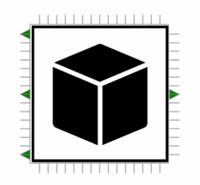Simcenter Flomaster provides numerous sample systems as pre-defined
templates. You start the Flomaster model from the sample system Ship to Shore, which models
a typical issue caused by sudden movement of water.
-
To load the sample system, Ship to Shore:
-
Launch Simcenter Flomaster version 2021.2 or later.
-
Select the system and click UNPACK.
-
In the pop-up dialog, accept the default settings and select
UNPACK.
-
In the Networks tab, to open the 1D network,
double-click the icon.
The flows coming from valves
60,8,61
and from valves
62,9,63 are replaced by the FMU
component that you exported from Simcenter STAR-CCM+. This FMU
represents the four-armed junction.
In the starting files, a pre-defined four-armed junction
component is available in which flow enters through three inlets, merges at a
junction, and leaves through the outlet. In Simcenter Flomaster, because there is no
built-in data for pressure drops in such a component, you import the surrogate model
from Simcenter STAR-CCM+ and configure it
appropriately.
-
To load the pre-defined component,
-
Select .
-
In the pop-up dialog, select the
four_armed_junction_noConnection.FMPck from
the starting files and click Open.
-
Accept the default settings and click Unpack.
The pre-defined component can be viewed within the
Catalogues tab, node.
You import the surrogate model and embed it into the
pre-defined component to create a fully defined four-armed junction.
-
To load the FMU file from Simcenter STAR-CCM+:
-
Select the Launchpad tab from the
toolbar.
-
In the launchpad, select the tab and choose New FMU
Component.
-
In the opened FMU Component Wizard, select the
junction_surrogates.fmu file exported from
the design study and click CREATE.
-
In the Component Customisation Form, accept
default settings and click OK.
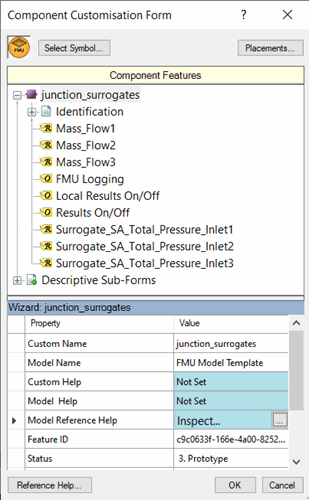
| Note | Simcenter Flomaster
uses SI units. In the case of non-SI units, the variables from the
FMU file must be converted in Flomaster using unit
converters. |
The imported surrogate can be viewed within the
Catalogues tab, .
-
To connect the FMU component junction_surrogates into the pre-defined
component:
-
Double-click the node to open the network of this component.
-
Select the junction_surrogates node and drag it
into the open network.
You can rotate the component clockwise using the

button from the toolbar.
-
To set up the mass flow balance, first connect
Inlets
(16,17,18) mass flow to
 Gauge Template controllers
(5,6,7) as Measure Input, selecting Mass
Flow Rate Result feature in the pop-up feature list.
Gauge Template controllers
(5,6,7) as Measure Input, selecting Mass
Flow Rate Result feature in the pop-up feature list.
-
Afterwards, connect the Output Signals of the Gauge
Template controllers(5,6,7) to
the
 3 Arm Sum controller (15)
as Input Signals.
3 Arm Sum controller (15)
as Input Signals.
When connecting Inlets
(16,17,18) to the FMU
component (1), select the corresponding
variable.
-
Connect the Output Signals of Gauge Template
controllers(5,6,7) to the
 FMU component (1) with the
corresponding variable selection:
FMU component (1) with the
corresponding variable selection:
| Gauge Template Controller Number |
FMU Variable |
| 5 |
Mass Flow 1 |
| 6 |
Mass Flow 2 |
| 7 |
Mass Flow 3 |
-
Connect the Output Signal of the 3 Arm Sum
controller (15) to the signal port
Mass Flow Rate of the Source:
Flow controller (9).
-
To set up pressure in the system, first connect the pressure from
Hydraulic Node
4 to each
 Summing
Junction controller (10,12,14) as
one Input Signal.
Summing
Junction controller (10,12,14) as
one Input Signal.
The pressure circuit goes from the outlet towards the
inlets. When making the connection, select the Hydraulic Node
Results: Pressure as the feature.
-
Add the pressure differences coming from FMU
component (1) to the Summing
Junction controllers (10,12,14)
as the second Input Signals.
When connecting the
FMU component
(1) to
Summing
Junction controllers
(10,12,14),
select the corresponding variable from the following table:
| Summing Junction Number |
FMU Variable |
| 10 |
Surrogate_SA_Total_Pressure_Inlet1 |
| 12 |
Surrogate_SA_Total_Pressure_Inlet2 |
| 14 |
Surrogate_SA_Total_Pressure_Inlet3 |
-
Connect the Output Signals of the Summing
Junction controllers (10,12,14)
to the Pressure port of the Source: Pressure
controllers (2,3,4) at the three inlets.
The fully connected network of the four armed junction
component is shown below:
After connecting the four-armed junction in the previous step,
you define the component including the FMU as a new composite component. You can
apply a composite component multiple times in the final network of the ship to shore
system — wherever four-armed junctions are required.
-
To define a new composite component:
-
In the open network of the completed four-armed junction, click and
drag to select all the elements using a bounding box.
-
Right-click on any element and select Extract Selection to Composite.
A New Composite Component appears in the node.
-
Select the Name of
this component property list and rename it to
four_armed_junction_connected.
-
To define the signal ports of this component, double-click to open the
network of the component.
-
In the Network View property window, select the
Connections tab and click
Deduce.
Flomaster derives the ports from the rest of the system.
The signal ports of this component are therefore mapped
automatically.
-
To arrange the Graphical Port Replacement, select the
Connections tab and click
Graphical View at the bottom.
In the opened window, drag arms
1,2,3 to the left hand side and arm
4 to the right hand side as shown in the
image below:
-
In the network Ship to Shore Model, you place the
four_armed_junction_connected component twice.
-
To open the network, in the Networks tab,
double-click the Ship to Shore Model to open the
network.
-
Delete the 6 connections from Valves
(60,8,61,62,9,63).
-
In the Catalogues tab, select the component and drag and drop it twice in the
Ship to Shore Model.
-
Connect the Valves
(60,8,61) to the first
four_armed_junction_connected component
(34) without selecting any variables and
Hydraulic Node
(82) to the 4th port of the component.
-
Connect the Valves
(62,9,63) to the second
four_armed_junction_connected component
(39) without selecting any variables and
Hydraulic Node
(82) to the 4th port of the component.
The new
Ship to Shore Model is shown
below:
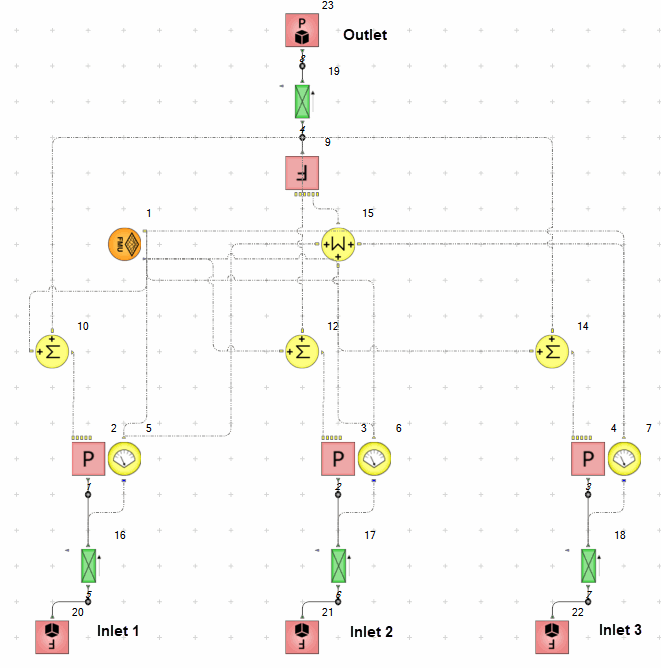
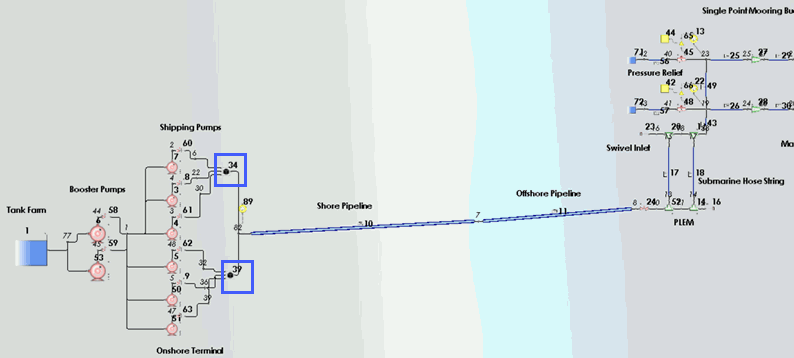
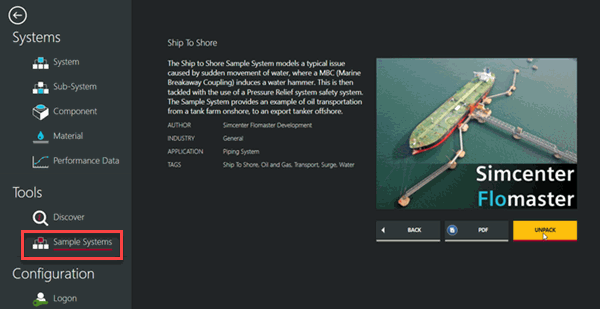
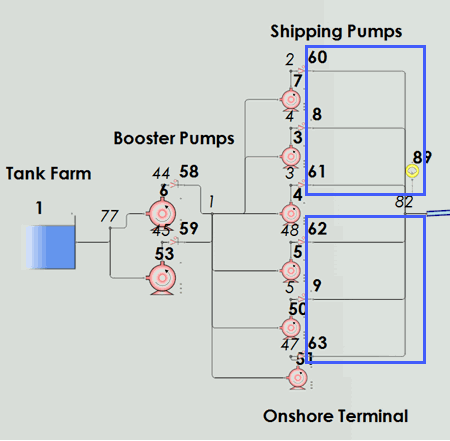

 button from the toolbar.
button from the toolbar.



